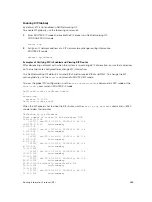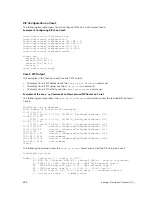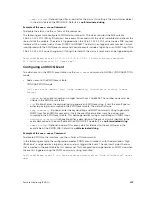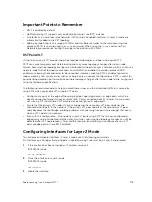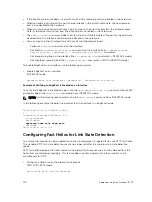
–
owner
string
: (Optional) specifies an owner for the alarm, this setting is the alarmOwner object
in the alarmTable of the RMON MIB. Default is a
null-terminated string
.
Example of the
rmon alarm
Command
To disable the alarm, use the
no
form of the command.
The following example configures RMON alarm number 10. The alarm monitors the MIB variable
1.3.6.1.2.1.2.2.1.20.1 (ifEntry.ifOutErrors) once every 20 seconds until the alarm is disabled, and checks the
rise or fall of the variable. The alarm is triggered when the 1.3.6.1.2.1.2.2.1.20.1 value shows a MIB counter
increase of 15 or more (such as from 100000 to 100015). The alarm then triggers event number 1, which
is configured with the RMON event command. Possible events include a log entry or an SNMP trap. If the
1.3.6.1.2.1.2.2.1.20.1 value changes to 0 (falling-threshold 0), the alarm is reset and can be triggered again.
Dell(conf)#rmon alarm 10 1.3.6.1.2.1.2.2.1.20.1 20 delta rising-threshold
15 1 falling-threshold 0 1 owner nms1
Configuring an RMON Event
To add an event in the RMON event table, use the
rmon event
command in GLOBAL CONFIGURATION
mode.
• Add an event in the RMON event table.
CONFIGURATION mode
[no] rmon event
number
[
log
] [trap community] [description string] [owner
string]
–
number
: assign an event number in integer format from 1 to 65535. The number value must be
unique in the RMON event table.
–
log
: (Optional) enter the keyword log to generate an RMON event log, it sets the eventType to
either log or log-and-snmptrap in the RMON event table. The default is None.
–
trap
community
: (Optional) enter the keyword trap and SNMP community string to generate
SNMP traps for an RMON event entry, it sets the eventType to either snmptrap or log-and-
snmptrap in the RMON event table. This option generates syslog as well along with SNMP traps.
–
description
string
: (Optional) specifies a description of the event, which is identical to the
event description in the eventTable of the RMON MIB. The default is a
null-terminated string
.
–
owner
string
: (Optional) owner of this event, which is identical to the eventOwner in the
eventTable of the RMON MIB. Default is a
null-terminated string
.
Example of the
rmon event
Command
To disable RMON on the interface, use the
no
form of this command.
In the following example, the configuration creates RMON event number 1, with the description “High
ifOutErrors”, and generates a log entry when an alarm triggers the event. The user
nms1
owns the row
that is created in the event table by this command. This configuration also generates an SNMP trap when
the event is triggered using the SNMP community string “eventtrap”.
Dell(conf)#rmon event 1 log trap eventtrap description “High ifOutErrors” owner
nms1
Remote Monitoring (RMON)
699
Summary of Contents for Z9000
Page 1: ...Dell Configuration Guide for the Z9000 System 9 7 0 0 ...
Page 80: ...grub reboot 80 Management ...
Page 128: ... 0 Te 1 1 Te 1 2 rx Flow N A N A 128 Access Control Lists ACLs ...
Page 491: ...Figure 70 Configuring OSPF and BGP for MSDP Multicast Source Discovery Protocol MSDP 491 ...
Page 496: ...Figure 73 MSDP Default Peer Scenario 1 496 Multicast Source Discovery Protocol MSDP ...
Page 497: ...Figure 74 MSDP Default Peer Scenario 2 Multicast Source Discovery Protocol MSDP 497 ...
Page 498: ...Figure 75 MSDP Default Peer Scenario 3 498 Multicast Source Discovery Protocol MSDP ...
Page 760: ...Figure 100 Single and Double Tag TPID Match 760 Service Provider Bridging ...
Page 761: ...Figure 101 Single and Double Tag First byte TPID Match Service Provider Bridging 761 ...

